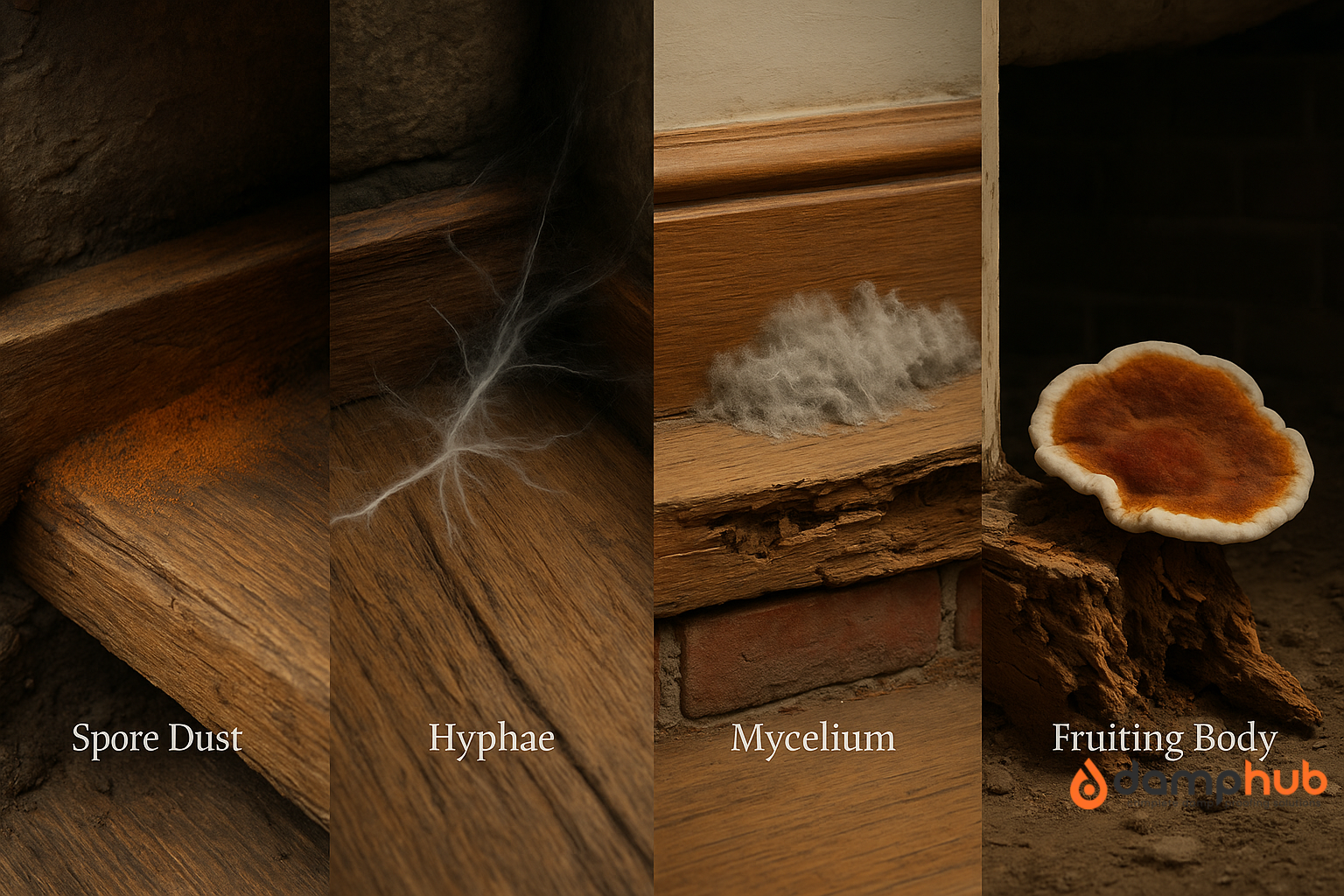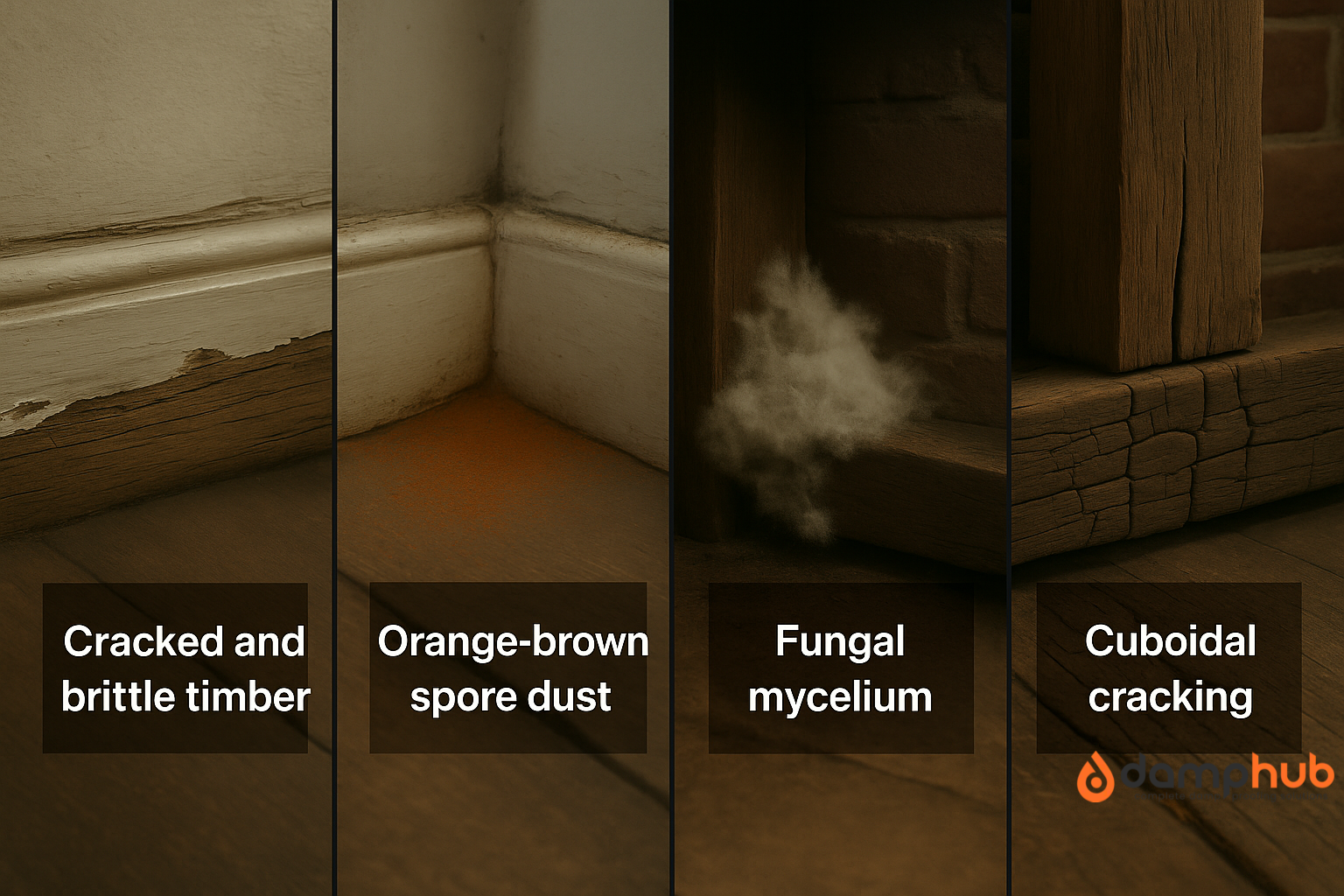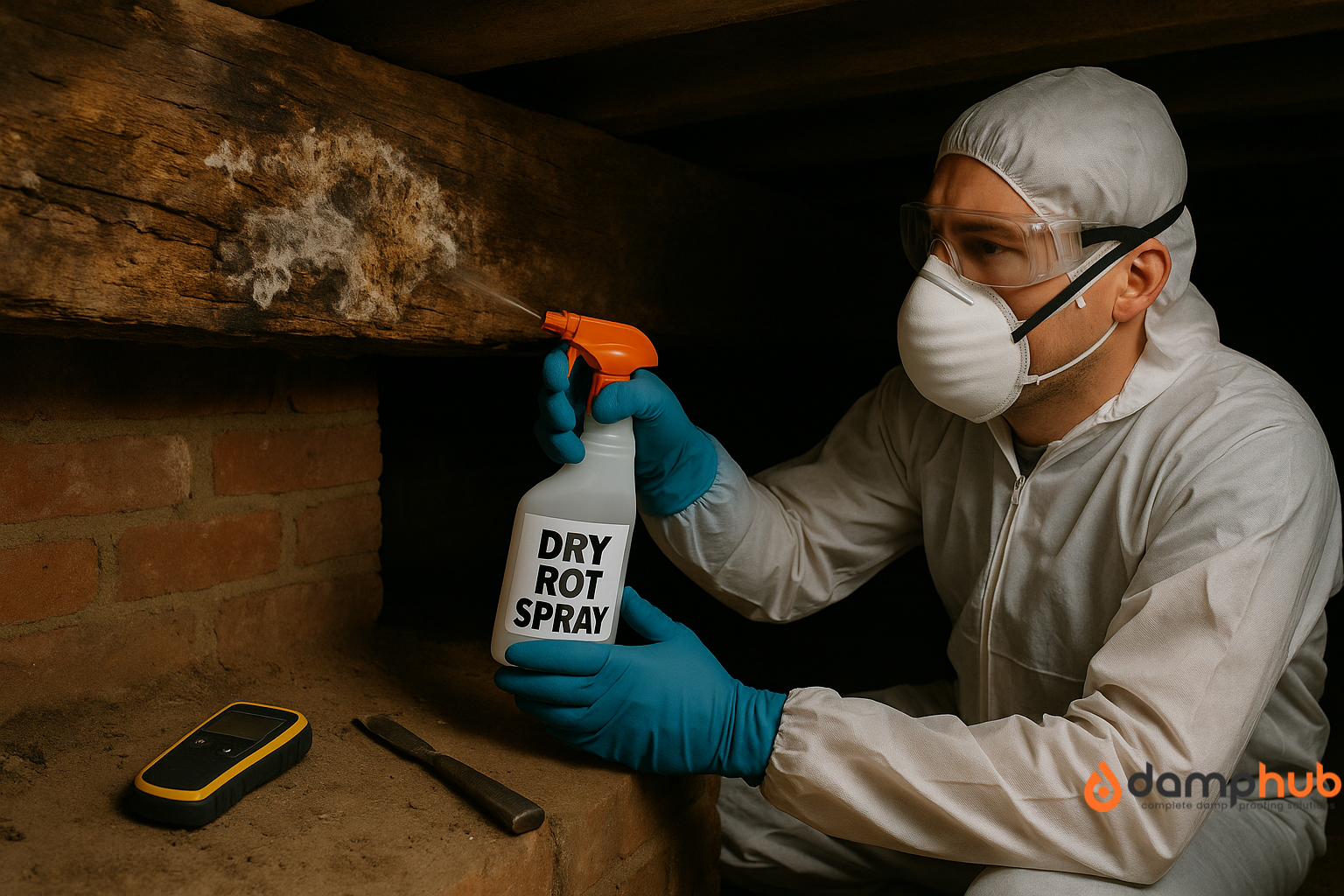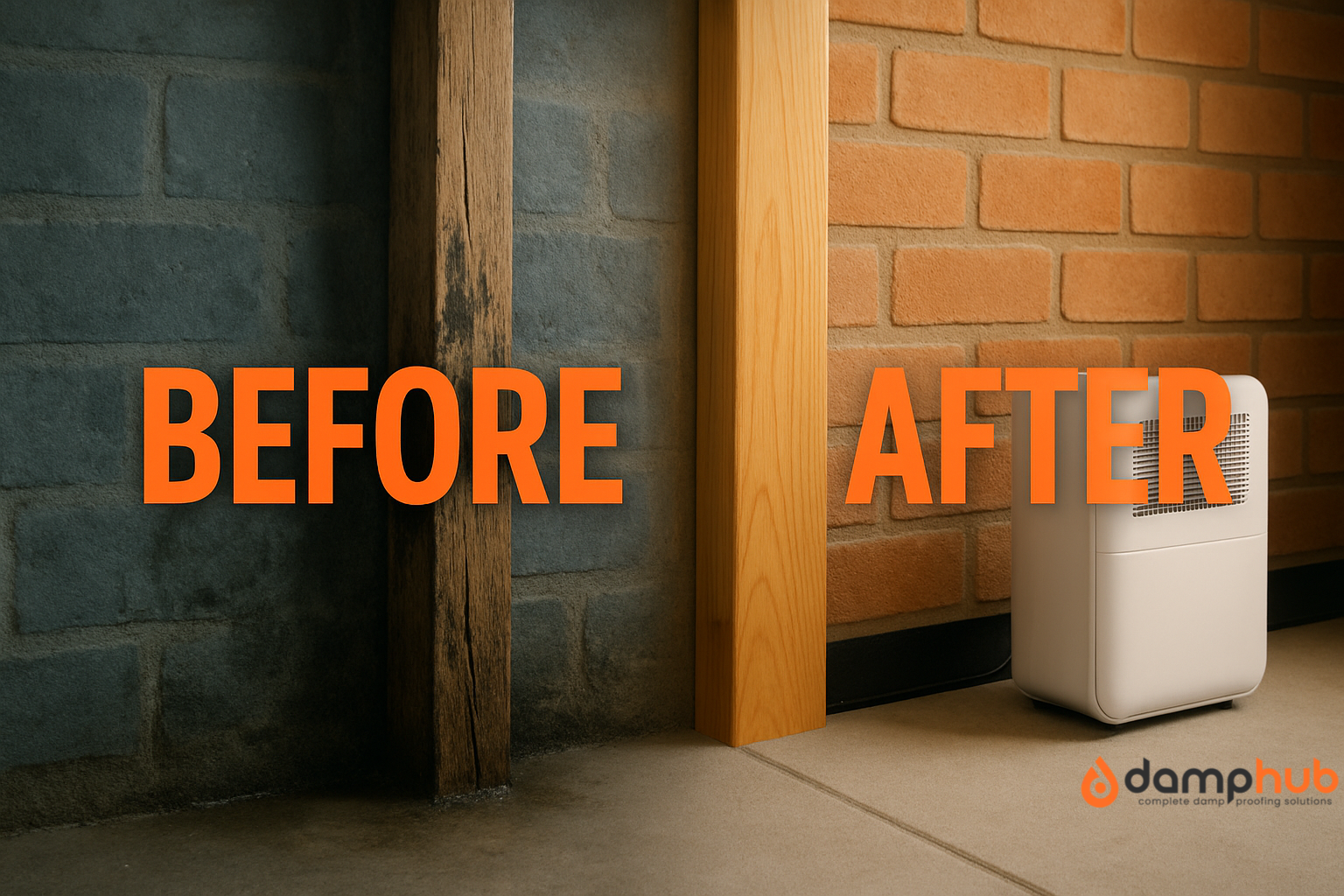
Key Takeaways
- Keep timber moisture under 15% – This stops rot from developing.
- Tackle damp signs early – Prevents costly structural damage.
- Check moisture levels regularly – Stay ahead of hidden problems.
- Fix the source – Don’t just cover up the symptoms.
- Prevention saves repairs – Protects your home’s structure and value.
In the UK, damp has a way of creeping into everyday life. You expect it outside — grey skies, drizzle that lasts for days — but when it gets into your home, that’s when it becomes trouble. Timber starts to swell. Paint peels. Rooms develop that unmistakable musty smell. And if you ignore it? That’s when rot moves in.
Both wet rot and dry rot have one essential ingredient: moisture. Without it, they can’t grow, spread, or damage your home. That’s why moisture control for rot prevention isn’t just a nice idea — it’s the foundation for keeping your property sound.
The good news? Moisture control doesn’t always mean ripping out floors or spending thousands. In most cases, it narrows down to habits, early checks, and knowing what to look for.
In this guide, we’ll go through the practical side of keeping your home dry, safe, and rot‑free. And we’ll do it in plain English. no jargon, no fluff.
What Is The Minimum Moisture Content Of Wood?
Every piece of timber contains water; it’s part of its natural structure. Even kiln‑dried wood still has a small percentage of moisture trapped in its fibres. That’s normal and healthy.
For timber used in buildings, the ideal range is 12–15% moisture content. At that level, wood stays stable and strong. But once it climbs above 20%, you’re in dangerous territory. That’s the level where the spores of dry rot fungi can germinate and start feeding.
The thing about this is, you often won’t see damage straight away. The wood may look fine for months. But inside, the fibres are starting to break down. By the time you spot crumbling timber or fungus growth, the problem’s already established.
Related post: What Percentage Damp Is Acceptable In Walls?
Good to Know
People sometimes assume treated timber can be left in damp conditions without worry. Unfortunately, it doesn’t work like that. Treatments buy you time, but they don’t remove the need for Moisture Control For Rot Prevention.
How To Tell If A House Has A Moisture Problem?
Some moisture problems are as obvious as a wet dog smell when you walk into a room. Others are slow, subtle, and easy to miss until real damage sets in.
Here are the signs of moisture you should look for:
- Condensation that Never Seems to Clear – If your windows are fogged up day after day, even when the heating’s on, your air is holding too much moisture.
- Patches of Black Mould – Whether it’s along skirting boards, behind furniture, or on ceilings, this is a strong sign of long‑term damp.
- Musty or Earthy Odour – A damp smell that doesn’t shift with cleaning usually means hidden damp, often in timber or under flooring.
- Soft or Springy Floorboards – Wood that feels “spongy” underfoot has likely absorbed too much water over time.
- Blistered Paint or Peeling Wallpaper – Often caused by moisture trapped behind the surface layer.
- White Powdery Marks on Walls – This is often salt brought to the surface by rising damp.

Pro Tip
Don’t assume a fresh coat of paint will fix it. Covering the signs of damp doesn’t solve the cause — and in some cases, it can trap moisture in and make the problem worse.
How Do You Test For Moisture In Your House?
You can’t embark on moisture control for rot prevention if you don’t know where it is. Thankfully, you’ve got a few options — some quick and cheap, others more technical.
- Moisture Meter – An inexpensive handheld device that gives you a digital reading. Pin‑type meters are best for timber; pinless models are good for finished walls.
- Foil Test – Tape a square of aluminium foil to the wall. After 24 hours, check for condensation. Moisture on the wall‑side means the damp is coming through the wall; on the room‑side, it’s condensation.
- Your Senses – Touch cold‑feeling walls, sniff out musty smells, and check for visible mould or staining.
🛠 Try This
After a spell of heavy rain, check under your sink, around window frames, and in the loft. These are often the first places to show signs of excess moisture.
How Do Home Inspectors Check For Moisture?
When you call in a damp surveyor or damp specialist, they’ll bring more than just a meter. They’re looking for patterns and causes, not just readings.
- Professional‑Grade Moisture Meters – More accurate and able to read deeper than standard DIY models.
- Thermal Imaging Cameras – Damp patches often show up as cooler areas on a heat scan.
- Humidity Testing – Hygrometers measure the moisture in the air.
- Borescopes – Small cameras used to peek inside wall cavities and under floors without major disruption.

Good to Know
An experienced inspector will combine these tools with knowledge of how UK homes are built. They can often trace damp back to a single cause — whether it’s a leaky gutter, poor ventilation, or rising damp.
What Moisture Content Is Needed For Dry Rot?
Dry rot might sound like it can survive without water, but that’s not true. It thrives in timber with a moisture content between 20–30%. That’s the range where its spores can germinate and spread.
Once active, dry rot is tenacious. It doesn’t just stay in the damp patch. It can send strands through brickwork, plaster, and mortar, travelling in search of more wood to attack.
Pro Tip
The best way to beat dry rot is to never give it those conditions in the first place — and that’s exactly why Moisture Control For Rot Prevention matters so much.
What Percentage Of Moisture Content Is Known As The Dry Rot Safety Line?
The safe number you’ll hear most from timber specialists is 15% moisture content. Below that, dry rot simply can’t survive.
Keeping timber under this line is like shutting the door on rot before it even knocks. The trick is making sure you’re not just dry now, but staying that way over the long term.
Try This
If you’ve had damp treatment or replaced damaged timber, keep a moisture meter handy. Check vulnerable spots monthly. It’s a cheap habit that can save you a lot of grief.
What Happens If You Have Too Much Moisture In Your House?
Here’s what happens when the moisture levels stay high:
- Your heating feels useless. Damp air is stubborn. You can run the boiler all day, but the house never seems cosy. That’s because moisture in the air is absorbing the warmth before you can feel it. The result? Higher bills and cold rooms.
- Mould makes itself at home. Given a damp corner and low airflow, mould will spread. It’s happiest on cold external walls, around window frames, and behind large bits of furniture. Left alone, it’s not just ugly — it’s a health hazard. Mould releases spores that can irritate lungs, especially in children or anyone with asthma.
- Your building materials start to fail. Plaster softens and crumbles. Wallpaper lifts away from the wall. Paint flakes off in long strips. If the timber is affected, you may start to notice floors dipping or skirting boards losing their shape.
- Health takes a hit. Damp air fuels dust mites and mould spores, both of which can trigger allergies, sinus issues, or breathing problems. A musty smell indoors is often the first warning sign that your air quality isn’t great.
- You attract pests. Damp timber is an open invitation to wood‑boring beetles. They don’t care if your home looks neat — if the moisture level in the wood is high enough, they’ll move in. Over time, they can weaken floorboards and joists.
These are all reasons why moisture control for rot prevention is worth thinking about early. Once timber is consistently wet, rot has what it needs to start spreading.

How To Solve Moisture Problems In A House? (Homemade Remedies And Professional)
Moisture problems don’t all need the same solution. Some are caused by everyday habits you can fix yourself. Others are the result of faults in the building, and those often need a professional’s hand.
The key is to deal with the cause, not just the symptoms.
Things You Can Do Yourself
- Let fresh air in daily. Even ten minutes of open windows in winter makes a difference. It swaps out heavy, damp air for fresh, dry air. Yes, you’ll lose some heat, but it’s worth it. Stale, damp air makes the house harder to heat in the long run.
- Use simple moisture absorbers. Bowls of table salt or baking soda work surprisingly well in small enclosed spaces like cupboards or wardrobes. Calcium chloride crystals are stronger and can pull a lot of water from the air quickly.
- Check for slow leaks. Look under sinks, behind washing machines, and around toilets. Even a slow drip can keep timber damp enough for rot. Fixing it early is cheaper than repairing rotten floors.
- Dry clothes wisely. Drying washing indoors without ventilation dumps litres of water into the air. If you have no choice, open a window in the drying room and keep the door shut to stop moisture from drifting through the house.
- Give furniture breathing space. Don’t push wardrobes and sofas right against cold external walls. Leave a gap to allow air circulation. This stops condensation and mould from forming behind them.
When To Call In A Professional For Moisture Control
- Roof and gutter issues. Missing tiles or blocked gutters let rainwater in — often without you realising. Over time, this seeps into walls and roof timbers.
- Ventilation systems. Positive Input Ventilation (PIV) units can work wonders in houses that struggle with condensation. They feed in filtered, dry air and help push moisture out.
- Serious damp problems. Rising damp and penetrating damp need targeted building work. These aren’t problems you can fix with salt bowls.
- Timber replacement. If you can sink a screwdriver into a joist or beam, the wood’s structure is gone. You’ll need it replaced or reinforced — and only after the moisture source has been removed.
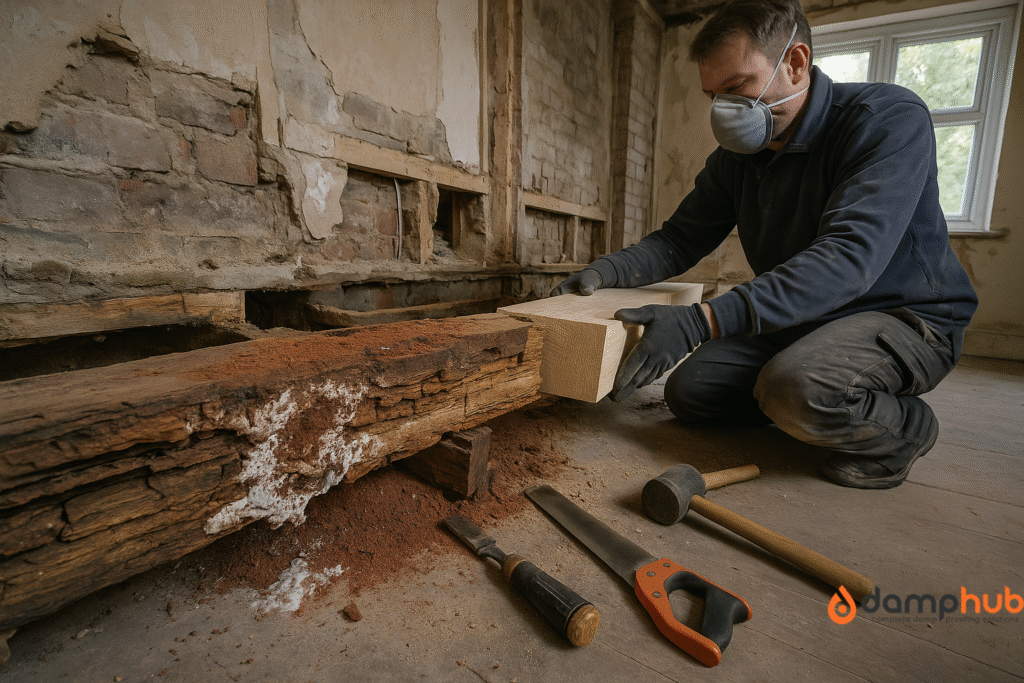
Pro Tip
Fixing the cause first is non‑negotiable. If you replace timber while the area is still damp, the new wood will rot just as fast as the old.
Final Thought
Moisture control for rot prevention is not a one‑off job; it’s an ongoing commitment to keeping your home healthy and structurally sound.
You start by identifying the warning signs early, testing moisture levels, and fixing problems before they escalate. This removes the conditions that allow rot to grow.
Doing it consistently will protect your timber, preserve your home’s value, and save you from costly repairs in the future.
Moisture Control For Rot Prevention: Your Questions Answered

-
How Do You Make a Homemade Moisture Trap?
If you aim to achieve moisture control for rot prevention with minimal cost, a simple bowl of table salt, baking soda, or moisture crystals will do the job in small, damp spots like cupboards. They draw moisture from the air and clump as they work. Swap them out when wet — a small but useful step in
-
How To Remove Moisture From Home Without a Dehumidifier?
Open windows daily, run extractor fans when cooking or bathing, and wipe condensation off windows each morning. For stubborn corners, pop in a bowl of salt.
-
How To Check Moisture Under a House?
Shine a torch under suspended floors to check for dark staining, mould, or damp timbers. A moisture meter reading above 20% means the wood’s in the rot danger zone. Early checks are vital for good moisture control for rot prevention.
-
How To Keep Moisture Away From House Foundation?
Keep gutters and downpipes clear, slope the ground away from your walls, and avoid piling soil or mulch against the house. These steps keep damp away from lower walls, boosting your efforts in moisture control for rot prevention.
-
How To Find Where Moisture Is Coming From in a House?
Finding the source is step one in effective moisture control for rot prevention. Look for leaks under sinks, roof damage, and cracks in brickwork. Track where condensation appears most often (kitchens, bathrooms, or cold corners) and undertake the right course of action.
-
What Is the Cheapest Homemade Moisture Absorber?
The cheapest option is plain table salt. Put it in a bowl and place it in damp‑prone spots like cupboards or wardrobes. The salt will clump as it absorbs moisture — replace it when wet. It’s a simple, low‑cost step in moisture control for rot prevention.
-
Why Does a House Have Too Much Moisture?
It’s usually poor ventilation, indoor moisture build‑up, or water getting in from outside. Left unchecked, these conditions are where rot can thrive. You should ensure better ventilation if your moisture control for rot prevention must bear results.
-
How To Get Moisture Out of Walls?
First, fix the cause — whether it’s a leak, poor ventilation, or rising damp. Then help the wall dry by improving airflow and keeping steady, gentle heat. In severe cases, professional damp treatment may be needed. For step‑by‑step guidance, see our full article on how to remove damp from walls.


